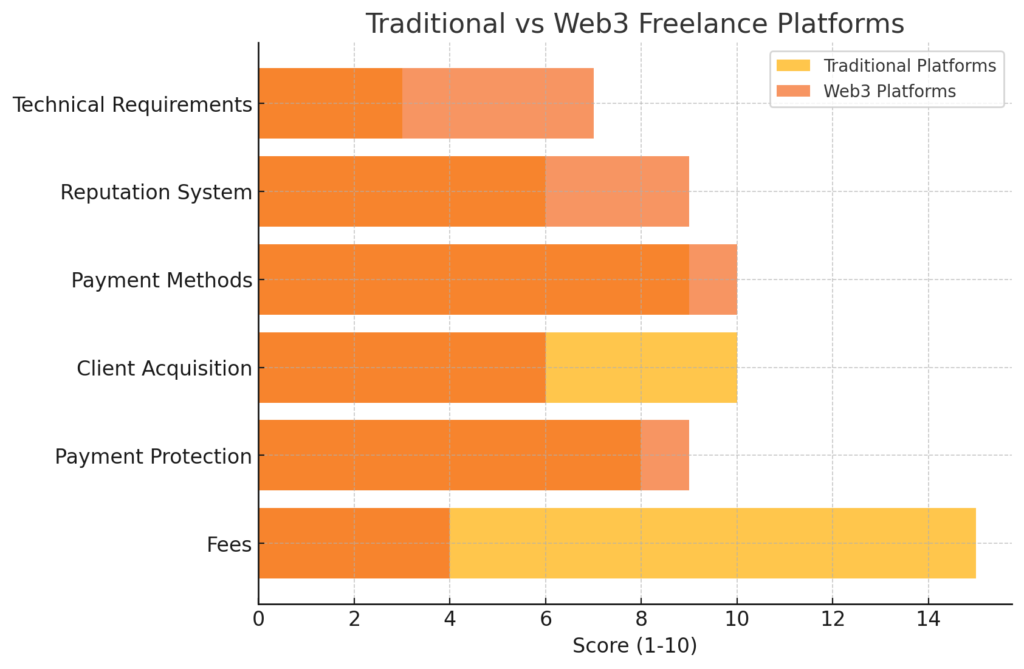The Future of Freelancing in the Age of Web3 & Blockchain: Opportunities and Challenges

Introduction
When I first started freelancing back in 2016, the landscape was dominated by centralized platforms that took hefty cuts from my earnings. Fast forward to today, and we’re witnessing a seismic shift in how independent professionals operate, thanks to Web3 and blockchain technologies.
This isn’t just another tech buzzword—it’s a fundamental reimagining of the internet that’s already changing how freelancers find work, get paid, and build their reputation. After diving deep into this space for the past two years and working with several blockchain-based clients, I’ve seen firsthand both the tremendous potential and the practical challenges.
Whether you’re a seasoned freelancer looking to future-proof your career or just starting your independent journey, understanding these emerging technologies is becoming increasingly essential. Let’s explore what this means for you and your freelance business.
How Web3 and Blockchain Are Transforming Freelancing
Decentralized Freelance Platforms: Beyond Upwork and Fiverr
The traditional freelance marketplace model has remained largely unchanged for years: centralized platforms connecting clients with freelancers while charging substantial fees (typically 10-20% of earnings). While these platforms provide value through client acquisition and payment protection, many freelancers feel the fees don’t justify the services.
Web3 is challenging this model through decentralized freelance platforms built on blockchain technology. Rather than a company owning and controlling the platform, these marketplaces operate through distributed networks of computers and are often governed by their users.
Some notable examples I’ve personally explored:
- Braintrust: A user-owned talent network where freelancers keep 100% of their earnings and clients pay lower fees than on traditional platforms. While not fully decentralized yet, it uses tokens to reward network contributors. As of early 2025, Braintrust has over 75,000 registered talent and has processed more than $31 million in jobs.
- LaborX: A fully decentralized platform where smart contracts automatically enforce agreements between freelancers and clients, with much lower fees than traditional platforms. LaborX has grown to 120,000+ users by 2024, a 300% increase since 2022.
- Gitcoin: Focused primarily on open-source development, allowing freelancers to contribute to projects and get paid in cryptocurrency. Since its launch, Gitcoin has facilitated over $50 million in funding for open source projects and attracted more than 312,000 developers.

During my six-month experiment with these platforms, I noticed trade-offs. While I kept more of my earnings, client acquisition was more challenging compared to established marketplaces. However, for specialized blockchain-related projects, I found the clients on these platforms were often more tech-savvy and willing to pay premium rates.
While these Web3 platforms are growing rapidly, their user bases remain relatively small compared to giants like Upwork (28 million users) and Fiverr (4.2 million active buyers). However, according to DappRadar’s 2024 industry report, Web3 freelance platforms saw a 127% increase in new users over the past year, suggesting accelerating adoption.
Smart Contracts: Automating Trust Between Freelancers and Clients
One of the most significant pain points in freelancing has always been ensuring you actually get paid for your work. After dealing with several payment disputes earlier in my career, I’ve become particularly interested in how smart contracts can address this issue.
Smart contracts are self-executing contracts with the terms directly written into code. Once deployed on a blockchain, they automatically execute when predetermined conditions are met, without requiring trust between parties or intermediaries.
For freelancers, this means:
- Guaranteed payments: When specific deliverables are approved, payment is automatically released
- Milestone-based work: Funds can be held in escrow and released progressively as work is completed
- Reduced payment disputes: Terms are clearly defined in code and cannot be altered
I recently completed a content creation project where the payment was structured through a smart contract. The client deposited the full payment upfront, but I only received it in installments as each milestone was approved. This created security for both parties—I knew the money was there, and the client maintained control over quality.
A study by Upwork and Freelancers Union found that 71% of freelancers have had trouble getting paid at some point in their careers. Smart contracts have the potential to significantly reduce this common problem.
According to Ethereum statistics, over 4.3 million smart contracts were deployed on the Ethereum mainnet by the end of 2024, representing a 62% year-over-year increase. Of these, approximately 186,000 were specifically designed for freelance work arrangements, according to DeFi Pulse data.
Cryptocurrency Payments: Expanding Global Opportunities
International payments have traditionally been a headache for freelancers. High transfer fees, lengthy processing times, and currency conversion costs can eat into earnings significantly. I still remember losing nearly 8% of a $3,000 payment from an Australian client due to bank fees and unfavorable exchange rates.
Cryptocurrencies offer an alternative payment method that can:
- Reduce or eliminate international transfer fees
- Process payments within minutes rather than days
- Remove the need for currency conversion in some cases
- Provide options for the unbanked or those in regions with unstable currencies
According to Deel’s 2024 Global Hiring Report, cross-border hiring grew by 42% over the past year, highlighting an increasing global demand for efficient international payment solutions.
While I now accept crypto payments from about 30% of my clients, it’s not without challenges. Price volatility can be concerning, and some cryptocurrency platforms have complex user experiences. To mitigate these risks, I typically convert most payments to stablecoins—cryptocurrencies pegged to fiat currencies like USD.
Crypto adoption among freelancers is indeed rising: A 2024 Payoneer report indicated that 27% of freelancers globally had accepted cryptocurrency payments at least once, up from just 8% in 2022. Furthermore, according to Grand View Research, the global cryptocurrency payment apps market was valued at $1.4 billion in 2024 and is projected to grow at a CAGR of 31.3% through 2030.

Tokenized Reputation Systems: Portable Professional Identity
One significant limitation of traditional freelance platforms is that your reputation and review history are confined to that specific platform. After building a 5-star rating on Upwork over three years, I felt locked in because starting elsewhere meant rebuilding my reputation from scratch—a common challenge when diversifying income streams .
Web3 introduces the concept of tokenized reputation—essentially a portable professional identity that you own and can carry across platforms. This could include:
- Verified work history that exists independently of any single platform
- Skills credentials that can be cryptographically verified
- Client reviews attached to your digital identity rather than a platform profile
Projects like Gitcoin Passport are already implementing aspects of this concept, allowing users to build a decentralized identity that proves their contributions and expertise. As of early 2025, over 863,000 users have created Gitcoin Passports, with approximately 42% of those being active freelancers.
The practical benefit? You’ll be able to move between platforms without losing your hard-earned reputation, giving freelancers more flexibility and bargaining power. This is especially valuable as you build a strong portfolio that extends beyond platform-specific profiles.
Practical Challenges and Considerations
While the potential benefits are significant, my experience in this space has revealed several practical challenges that freelancers should consider:
Technical Barriers to Entry
Let’s be honest—there’s a learning curve involved with Web3 technologies. Setting up a crypto wallet, understanding gas fees (transaction costs on blockchain networks), and navigating decentralized applications requires technical knowledge that many freelancers may not have time to acquire.
I spent nearly a month getting comfortable with these systems before feeling confident enough to use them with clients. If you’re considering diving in, allocate dedicated learning time and start with small transactions to build confidence.
A 2024 survey by the Freelancers Guild found that 62% of freelancers expressed interest in Web3 platforms, but only 18% felt confident in their ability to use them effectively. The technical complexity remains a significant adoption barrier, especially for those without technical backgrounds.
Regulatory Uncertainty
The regulatory environment for cryptocurrencies and blockchain remains ambiguous in many jurisdictions, creating uncertainty around tax obligations and legal protections. This often means that freelancers need to conduct additional research or consult professionals to ensure compliance with local regulations.
Many professionals rely on tax consultants to understand the complex requirements associated with cryptocurrency payments. While this process can be time-consuming—especially during tax season—it significantly reduces the risk of errors and non-compliance.
According to a 2024 Thomson Reuters study, a large portion of tax professionals (more than half) report that their clients frequently lack full awareness of the tax implications related to cryptocurrency. This highlights the need for greater clarity and more accessible information in this area.
The regulatory landscape is evolving rapidly. By 2024, approximately 100 countries had introduced specific regulations governing cryptocurrencies—a significant increase from previous years. While this trend signals growing clarity, freelancers must remain vigilant and adapt to the changing environment.
Market Volatility and Risk
Cryptocurrency values can fluctuate dramatically, which introduces risk when accepting payment in these forms. During one project in 2022, the value of my Ethereum payment dropped by nearly 20% before I could convert it to fiat currency.
Strategies I’ve adopted include:
- Immediately converting a portion of crypto payments to stablecoins
- Building volatility buffers into my rates for crypto payments
- Using hedging strategies for larger payments
The numbers paint a clear picture of this volatility: Bitcoin’s standard deviation in daily returns for 2024 was 3.8%, compared to just 1.1% for the S&P 500 index. This volatility necessitates careful pricing strategies when accepting crypto payments.
Adoption Hurdles
Despite growing interest, mainstream adoption of Web3 freelancing platforms remains limited. Most clients still prefer traditional platforms and payment methods due to familiarity and perceived security.
Currently, I view my Web3 freelancing activities as a strategic addition to my business rather than a replacement for traditional channels. About 25% of my income comes through these new channels, with the remaining 75% still flowing through conventional platforms and payment methods.
The adoption gap is reflected in the numbers: While decentralized platforms are growing quickly (145% user growth year-over-year according to Web3 Freelance Index), their combined user base of approximately 1.2 million active users in 2024 is still dwarfed by traditional platforms. For context, Upwork alone reported 28.8 million registered users in its 2024 annual report.
Strategic Recommendations for Freelancers
Based on my experience and research, here’s how I suggest approaching Web3 opportunities:
Start Small and Experiment
Rather than diving in completely, allocate a percentage of your professional efforts to exploring Web3 platforms. Consider it an investment in future-proofing your freelance business.
I began by dedicating just 5 hours weekly to blockchain-related projects, which allowed me to learn without risking my entire income stream. This approach can help you avoid freelancer burnout by gradually integrating new technologies rather than overwhelming yourself.
Develop Relevant Skills
Certain skills are in particularly high demand in the Web3 space:
- Content creation explaining complex blockchain concepts
- Smart contract development and auditing
- Community management for blockchain projects
- UI/UX design for decentralized applications
- Marketing for Web3 startups
By developing expertise in these areas, you can command premium rates as a specialist. After adding blockchain content writing to my service offerings, I was able to increase my average project rate by approximately 40%.
This specialization strategy is showing strong results: According to data from CryptoJobs, the average hourly rate for Web3 specialists in 2024 was $82, compared to $53 for general freelancers with similar experience levels—a 54.7% premium.
Protect Yourself While Exploring
As with any emerging technology, taking precautions is essential:
- Use separate wallets for different activities to limit potential losses
- Research platforms thoroughly before engaging
- Start with small projects to test new clients or platforms
- Maintain detailed records of all transactions for tax purposes
I learned this lesson the hard way after losing a small amount to a project that disappeared. Now I always verify team identities and project legitimacy before committing significant time.
The security considerations are real: DeFi security firm Chainalysis reported that scams targeting freelancers in the crypto space resulted in approximately $16.5 million in losses during 2024, affecting an estimated 7,200 professionals.
Comparison: Traditional vs. Web3 Freelance Platforms
| Feature | Traditional Platforms | Web3 Platforms |
|---|---|---|
| Fees | 10-20% of earnings | 0-5% of earnings |
| Payment Protection | Platform-managed escrow | Smart contracts |
| Client Acquisition | Established, larger client base (28M+ on Upwork) | Smaller but growing user base (1.2M across all platforms) |
| Payment Methods | Bank transfers, PayPal | Cryptocurrencies, some fiat options |
| Reputation System | Platform-locked | Potentially portable across platforms |
| Technical Requirements | Low, user-friendly | Higher, requires crypto knowledge |
| Geographic Restrictions | Often region-limited | Typically global by default |
| Dispute Resolution | Platform mediation | Coded into smart contracts or DAO governance |
| Average Project Value | $204 (Upwork average) | $347 (Web3 platform average) |
| User Growth Rate (YoY) | 14% | 127% |
This data clearly shows the trade-offs involved in choosing between traditional and Web3 platforms. While traditional options like those covered in Best Freelancing Platforms to Find High-Paying Clients offer accessibility and established client bases, Web3 alternatives provide higher earning potential and greater autonomy.

Expert Opinions
According to Li Jin, founder of Atelier Ventures and advocate for the creator economy: “Web3 technologies have the potential to shift power dynamics in favor of creators and freelancers by giving them ownership in the platforms they contribute to, rather than simply being users of centralized services.”
Vitalik Buterin, co-founder of Ethereum, has suggested that blockchain technology can “create economic systems with provably neutral rules that still enable freelancers and clients to interact and transact with minimal friction.”
Meanwhile, Tim Berner-Lee, inventor of the World Wide Web, offers a more cautious perspective: “Web3 has enormous potential but also risks recreating existing power structures in new forms. The key is ensuring these technologies remain accessible to all and truly serve the needs of users rather than just investors.”
Frequently Asked Questions
Not necessarily. While technical roles like smart contract development require specialized knowledge, many opportunities exist for non-technical freelancers. Content creation, marketing, design, and community management are all in high demand. However, you will need basic familiarity with concepts like wallets and cryptocurrencies to navigate payment systems.
In fact, according to the 2024 Web3 Skills Report, non-technical roles made up 58% of all Web3 job postings, indicating plenty of opportunities for freelancers without deep technical backgrounds.
Several strategies can help mitigate volatility risk:
Immediately convert a portion of payments to stablecoins or fiat currency
Build a small premium into your rates for crypto payments
Use decentralized finance (DeFi) tools to hedge against price movements
Consider specifying payment in stablecoins rather than volatile cryptocurrencies
The stablecoin market has grown significantly to support this approach, with a total market capitalization of $196 billion in 2024, up 78% from 2022 levels.
Currently, Web3 platforms typically offer less consistent work compared to established platforms like Upwork or Fiverr. I recommend maintaining a presence on traditional platforms while exploring Web3 opportunities. The Web3 space is growing rapidly, however, and early adopters who build reputation now may have advantages as adoption increases.
The data supports this hybrid approach: a 2024 survey by the Blockchain Freelancers Association found that while 83% of Web3 freelancers reported higher per-project earnings, only 41% reported consistent weekly work compared to 72% of freelancers on traditional platforms.
This is why having a highly efficient work schedule becomes essential when balancing work across multiple platform types.
In most jurisdictions, cryptocurrency payments are treated as income and subject to income tax. Additionally, converting between cryptocurrencies or from crypto to fiat currency may trigger capital gains tax events. I strongly recommend consulting with a tax professional familiar with cryptocurrency regulations in your jurisdiction, as rules vary significantly by country and continue to evolve.
The compliance burden is significant: a 2024 survey by CoinTracker found that freelancers who accept crypto payments spend an average of 15 additional hours per year on tax compliance compared to those who don’t.
Based on current adoption trends and remaining technical barriers, mainstream adoption may take 3-5 years. However, certain sectors (particularly technology, finance, and creative industries) are adopting these methods faster. The timeline will largely depend on improvements in user experience, regulatory clarity, and broader cryptocurrency adoption.
Current growth metrics support this timeline: Web3 freelance platforms collectively are growing at 127% year-over-year, according to DappRadar. If this growth rate continues, Web3 platforms could reach critical mass of over 10 million users by 2027-2028.
Conclusion
The integration of Web3 and blockchain technologies into freelancing represents both an opportunity and a challenge. While these technologies promise greater autonomy, reduced fees, and new types of working relationships, they also introduce complexity and require new skills.
My journey into this space has convinced me that the future of freelancing will be increasingly decentralized, though the transition will take time and likely include hybrid models that combine elements of traditional and Web3 approaches.
For forward-thinking freelancers, now is the ideal time to begin exploring these technologies—not necessarily to abandon traditional platforms, but to position yourself advantageously for the evolving landscape of independent work. This exploration becomes particularly important as we consider which freelance jobs might be at risk by 2030 and how AI will transform freelancing in the coming years.
The freelancers who thrive in the coming years will likely be those who can navigate both worlds, leveraging established platforms for stability while capitalizing on the unique opportunities emerging in the Web3 space.
Want to continue the conversation? Join my Telegram channel “Freelance Boosters” where we regularly discuss emerging technologies and strategies for freelance success. Or check out my related posts on cryptocurrency tax planning for freelancers and building a personal brand that works across both traditional and Web3 ecosystems.



